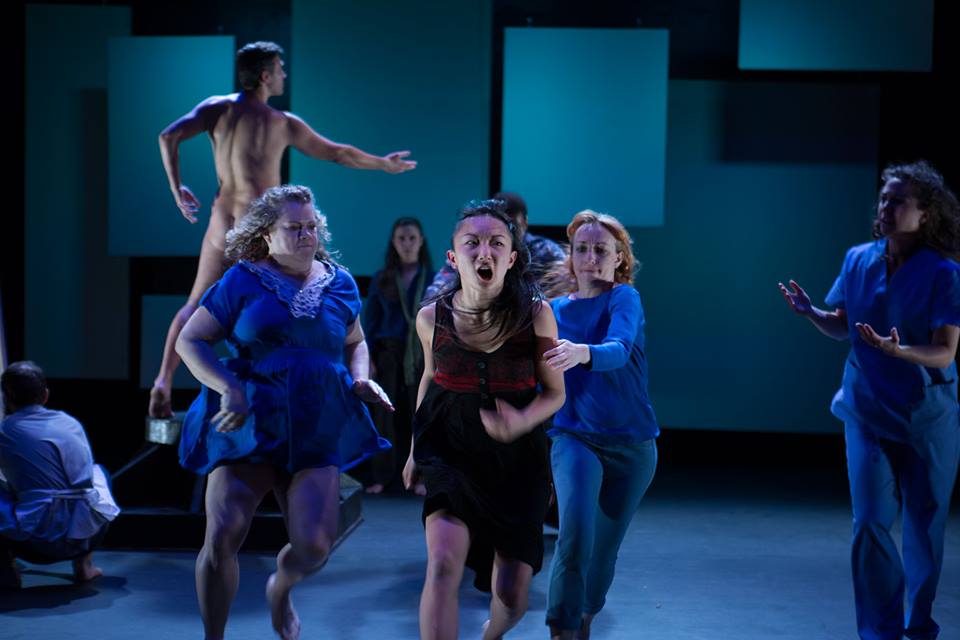Blessed Unrest’s BODY is subtitled “Anatomies of Being,” the many, or the several, brought together, like cells in the body, in a one entity. It was conceived and directed by Jessica Burr, scripted by Matt Opatrny in collaboration with the ensemble that created it. There were anonymous interviews along the way, and a visual artist, and the production team. BODY unites half-a-dozen stories, fictionally merged, I take it, with aspects of the actors’ lives. It is, despite its many origins, seamless, organically birthed and a being in life.
We see bodies distinguished by skin color, surgical reconstruction, facial hair, sexuality, anatomical sex, clothing (especially as associated with professions – a painter’s smock, surgical scrubs), hair color (and style), weight, and tattoo. There’s a range, albeit narrow, of apparent ages. There’s a painter of nudes (Nathan Richard Wagner) and his model (Darrell Stokes), a cancer survivor from a place near Chernobyl whose breasts have been reconstructed “for us” – and her (Tatyana Kot), a trauma surgeon with whom she has a romance (Catherine Gowl), a frank-talking woman who calls herself “fat” and makes us feel however we do about that (Sevrin Anne Mason), an Italian neuroscientist (Sonia Villani) and a tattoo artist (Joshua Wynter), a vivacious young woman who embodies both life and loss (Poppy Liu), and a narrator/anthropologist whose educational snippets are worthy of the best public television (Natalia Ivan Escobar). Their stories, often interlocking, raise questions about bodies and identity, theirs and our own.
Burr’s forte is physical theater, and the style of BODY is as much compositional as dramatic. The actors, with the help of Jay Ryan’s lights and a set by Opatrny, define the space and, at any given time, the visual focus, with their bodies. Properties are a mere handful. Two structures identical to the bases of the existing pillars in the converted industrial space serve as pedestals, or altars; a raised area on the side as a platform for wordless action. The costumes by Sydney Maresca are spare, but important; the artist’s smock worn by Wagner is spattered with red, which is ostensibly paint, but looks, from a bodily perspective, like blood. We are allowed, as audience, to make such associations and let them sit; even the science conveyed so well by Escobar is the sort that makes you think. The colors associated with race are, she points out, misnomers: skin isn’t white or black in the way that a green scarf is genuinely green, and light skin in shadow has a darker color value than dark skin in highlight. Such moments are exquisitely Brechtian, theatrical demonstrations that make us rethink a social drama in which we also have parts.
For all the show’s body diversity, there are differences it doesn’t display, not all our individual ones, which would be impossible, but some obvious broad categories. There’s not a disabled body (although a cast member works with them in life), or an elderly body (although Stokes, not remotely old, laments that his is changing), or a trans body (so far as I know). I wondered about bodies shaped by a broader spectrum of work or everyday pastimes, by sport, physical labor, or hunching over a computer (work for some is being). If there’s an Everybody in BODY, it’s the one beneath the skin: the bones, nerves and muscles we’re invited by the “black” cast member to imagine, in which, if we’re not really alike, we’re less superficially different.
The bodies we see are frequently nude, which is less a “thing” than might be expected. It feels routine as a locker room, or a collective shower. There’s no self-consciousness, or none that shows. Blessed Unrest is marked, in general, by brave self-disclosure, tastefully performed, without prurience or exploitation. BODY is frank without being Rabelaisian. The bodily functions are mentioned, but not portrayed, much less engaged in, even eating or drinking. There’s a post-coital cuddle, staged as though seen from above, and a quick wet kiss, and a sniffed finger that’s been in a certain place, but that’s about it. I wondered if BODY might not be a little too tame, but that’s because it’s a show that makes you wonder. I wouldn’t change a thing about it. It accepts itself for what it is, although, like a body aging, how it looks and feels tomorrow will not be the same as today.
BODY: ANATOMIES OF BEING plays through May 21 at the New Ohio Theatre. For tickets and information, click here. Event photo by Alan Roche.
